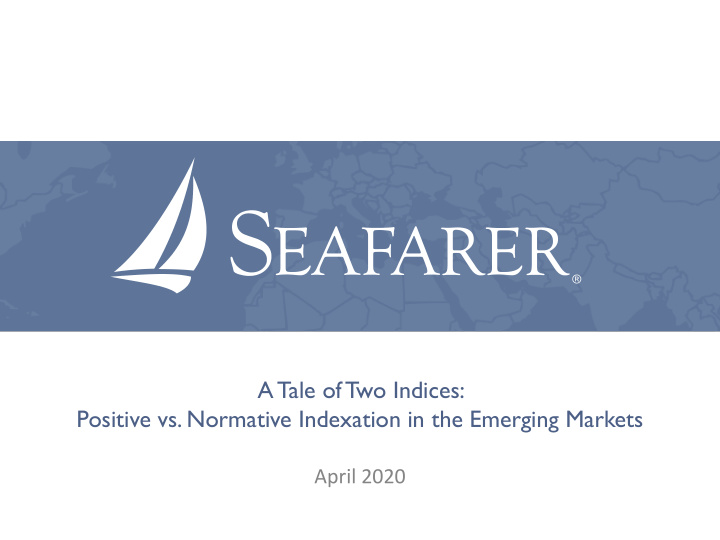



A Tale of Two Indices: Positive vs. Normative Indexation in the Emerging Markets April 2020
A Tale of Two Indices – Overview Available at www.seafarerfunds.com/a-tale-of-two-indices Steph Gan examines questions that are fundamental to the emerging market asset class: How are emerging market indices designed, and what are their objectives? In what manners do the benchmarks excel, and what are their limitations? Because capitalization-based indices are inherently backward-looking, countries and industries that represent the next leg of the developing world’s “emergence” are likely to be under-represented in the leading EM index. 2
Meaningful Capitalization Not Captured in Benchmarks Equity Market Capitalization Tracked by MSCI Indices As of 12/31/00; 12/31/10; 3/31/20 Capitalization, Indexed Capitalization, Not Indexed $30 Market Capitalization, USD Trillions $25 $20 $15 $10 $5 $0 2000 2000 2000 2010 2010 2010 2020 2020 2020 EM US EU EM US EU EM US EU Reference indices are MSCI Emerging Markets, MSCI US, and MSCI Europe. Total EM and EU equity market capitalizations are calculated as the sum of capitalizations for companies trading above $100 million. EM equity market capitalization is calculated as the sum of capitalizations for 26 countries included in the MSCI EM Index: Argentina, Brazil, Chile, China, Colombia, Czech Republic, Egypt, Greece, Hungary, India, Indonesia, Korea, Malaysia, Mexico, Pakistan, Peru, Philippines, Poland, Qatar, Russia, Saudi Arabia, South Africa, Taiwan, Thailand, Turkey and United Arab Emirates. US equity market capitalization is from the Bloomberg United States Exchange Market Capitalization USD Index. EU equity market capitalization is calculated as the sum of capitalizations for 15 developed European countries included in the MSCI EU Index: Austria, Belgium, Denmark, Finland, France, Germany, Ireland, Italy, the Netherlands, Norway, Portugal, Spain, Sweden, Switzerland and the UK. Sources: Bloomberg, FactSet, Seafarer. 3
What Belongs In a Passive Index? Comparison of Two Leading Emerging Market Indices MSCI EM Index FTSE EM All Cap China A Inclusion Index Market Capitalization Mid- and large-cap Small-, mid-, and large-cap Countries Represented 26 24 Inclusion South Korea Yes No; Developed Market classification Kuwait No; Frontier Market classification Yes Poland Yes No; Developed Market classification Chinese A-Shares Yes; Partial Weight Yes; Partial Weight Number of Constituents 1,404 4,043 Cumulative Weight of Top 10 Constituents 24.5% 22.0% Market Cap Statistics (USD million), free-float weighted Average 4,430 1,524 Largest 358,941 369,054 Smallest 104 10 Median 1,687 246 Market Cap Statistics (USD million), not weighted Average 14,310 5,058 Largest 1,879,348 1,879,348 Smallest 174 20 Median 6,087 1,422 As of 12/31/2019. Sources: MSCI, Factset, FTSE Russell, Bloomberg. 4
Defining a Positive Benchmark for Comparison Comparison of MSCI EM Index and Seafarer’s “Positive” EM Benchmark MSCI EM Index Positive EM Benchmark Number of Constituents 1,404 10,800 Countries Represented 26 26 Index Market Cap (USD million) 6,220,193 27,788,490 Index Market Cap as % of Positive EM 22.4% 100.0% Cumulative Weight of Top 10 Constituents 24.5% 17.1% Market Cap Statistics (USD million), not weighted Weighted Average 115,674 185,639 Median 6,087 524 Lowest 174 100 Highest 1,879,348 1,879,348 Seafarer defines an objective “positive” benchmark as comprising companies with an equity market capitalization of at least USD 100 million in 26 EM countries, as defined by MSCI. Argentina, Brazil, Chile, China, Colombia, Czech Republic, Egypt, Greece, Hungary, India, Indonesia, Korea, Malaysia, Mexico, Pakistan, Peru, Philippines, Poland, Qatar, Russia, Saudi Arabia, South Africa, Taiwan, Thailand, Turkey and United Arab Emirates. As of 12/31/2019. Sources: Bloomberg, MSCI, Seafarer. 5
MSCI EM Index Country Exposure Country Exposure Comparison – Normative MSCI EM Index and Positive EM Benchmark 50% A-shares in Positive EM Benchmark A-shares in Normative MSCI EM Index Positive EM Benchmark Normative MSCI EM Index 40% Country Exposure % 30% 20% 10% 0% Mexico Russia Taiwan China + HK All other Thailand Saudi Arabia South Africa Brazil India South Korea As of 12/31/2019. Sources: Bloomberg, MSCI, Seafarer. 6
MSCI China A-Shares Inclusion Journey As of 12/31/2019. Sources: MSCI, Seafarer. 7
MSCI EM Index Industry Exposure Industry Exposure Comparison – Normative MSCI EM Index & Positive EM Benchmark 40% 120% Normative MSCI EM Weight % [LHS] Positive EM Benchmark Weight % [LHS] 30% 90% MSCI Over-Under Weight % MSCI EM Over-Under Weight % [RHS] Sector Exposure Weight % 20% 60% 10% 30% 0% 0% -10% -30% -20% -60% Industrials Real Estate Health Care Consumer Staples Utilities Materials Consumer Discretionary Financials Information Technology Communication Services Energy As of 12/31/2019. Sources: Bloomberg, MSCI, Seafarer. 8
Capitalization Focus Can Determine Sector Exposure Industry Weighting by Company Capitalization Size Positive EM Benchmark > $50 Billion $10-50 Billion $3-10 Billion < $3 Billion 80% 70% % of Sector Capitalization 60% 50% 40% 30% 20% 10% 0% Consumer Consumer Energy Financials Health Care Industrials Materials Real Estate Utilities Communication Information Discretionary Staples Technology Services Note: Small-cap stocks are markedly under-represented in certain sectors (indicated with red labels: Energy, Communication Services, and Financials), but enjoy strong representation in other sectors (with green labels: Consumer Discretionary, Health Care, Industrials, and Materials). As of 12/31/2019. Sources: Bloomberg, MSCI, Seafarer. 9
Recommend
More recommend